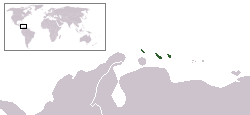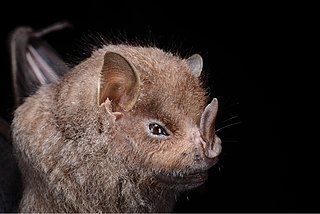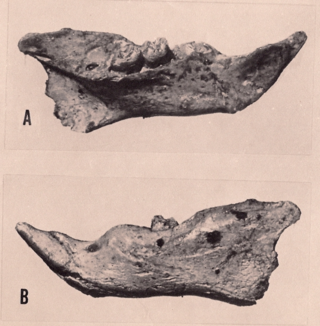
The Netherlands Antilles was a constituent country of the Kingdom of the Netherlands. The country consisted of several island territories located in the Caribbean Sea. The islands were also informally known as the Dutch Antilles. The country came into being in 1954 as the autonomous successor of the Dutch colony of Curaçao and Dependencies. The Antilles were dissolved in 2010. The Dutch colony of Surinam, although it was relatively close by on the continent of South America, did not become part of the Netherlands Antilles but became a separate autonomous country in 1954. All the island territories that belonged to the Netherlands Antilles remain part of the kingdom today, although the legal status of each differs. As a group they are still commonly called the Dutch Caribbean, regardless of their legal status. People from this former territory continue to be called Antilleans in the Netherlands.

The ABC islands is the physical group of Aruba, Bonaire, and Curaçao, the three westernmost islands of the Leeward Antilles in the Caribbean Sea. These have a shared political history and a status of Dutch underlying ownership, since the Anglo-Dutch Treaty of 1814 ceded them back to the Kingdom of the Netherlands, as Curaçao and Dependencies from 1815. They are a short distance north of the Falcón State, Venezuela. Aruba and Curaçao are autonomous, self governing constituent countries of the Kingdom of the Netherlands, while Bonaire is a special municipality of the Netherlands. Territories of the Kingdom of the Netherlands, the countries, and its special municipalities, are outside the European Union; citizens have Dutch nationality and the former colonial power benefits from preferential trade, mineral and natural resource rights, particularly offshore.

Miller's long-tongued bat is a bat species found in northern Brazil, Venezuela, Colombia, Guyana, Trinidad and Tobago, Grenada, the Netherlands Antilles and the U.S. Virgin Islands.
Pristimantis euphronides is a species of frog in the family Strabomantidae. It is endemic to Grenada, an island in the Lesser Antilles, the Caribbean. Is sometimes known as the Grenada frog. It was originally described as a subspecies of Eleutherodactylus urichi, but since 1994 it has been recognized as a full species.
Pristimantis shrevei is a species of frog in the family Strabomantidae. It is endemic to Saint Vincent, the West Indies. Its common name is Saint Vincent frog.

The Guadeloupe big-eyed bat is a species of bat in the family Phyllostomidae. It is found in Guadeloupe and Montserrat. It is threatened by habitat loss mostly because of Hurricane Hugo, which destroyed 90% of its population in 1989. The species may be locally extinct in some areas of Guadeloupe.
The Caribbean bioregion is a biogeographic region that includes the islands of the Caribbean Sea and nearby Atlantic islands, which share a fauna, flora and mycobiota distinct from surrounding bioregions.

Iguana is a genus of herbivorous lizards that are native to tropical areas of Mexico, Central America, South America, and the Caribbean. The genus was first described in 1768 by Austrian naturalist Josephus Nicolaus Laurenti in his book Specimen Medicum, Exhibens Synopsin Reptilium Emendatam cum Experimentis circa Venena. Three species are placed in the genus: the green iguana, which is widespread throughout its range and a popular pet, the marine iguana and the Lesser Antillean iguana, which is native to the Lesser Antilles. Genetic analysis indicates that the green iguana may comprise a complex of multiple species, some of which have been recently described, but the Reptile Database considers all of these as subspecies of the green iguana.

Megalomys audreyae, known as the Barbudan (?) muskrat or the Barbuda giant rice rat, is an extinct oryzomyine rodent from Barbuda in the Lesser Antilles. Described on the basis of a single mandible with the first molar missing and an isolated upper incisor, both of uncertain but Quaternary age, it is one of the smaller members of the genus Megalomys. Little is known about the animal, and its provenance and distinction from "Ekbletomys hypenemus", an even larger extinct oryzomyine that also occurred on Barbuda, have been called into question. The toothrow in the lower jaw has a length of 8.7 mm at the alveoli. The third molar is relatively narrow and both the second and third molars have a wide valley between their outer cusps.
Megalomys curazensis is a species of rodent from the Late Pleistocene of the island of Curaçao, off northwestern Venezuela. It is a member of the genus Megalomys, which also includes species from other islands of the Lesser Antilles. It is known from abundant but fragmentary material found throughout the island.

Gecarcinus ruricola is a species of terrestrial crab. It is the most terrestrial of the Caribbean land crabs, and is found from western Cuba across the Antilles as far east as Barbados. Common names for G. ruricola include the purple land crab, black land crab, red land crab, and zombie crab.

Fenimorea fucata is a species of sea snail, a marine gastropod mollusc in the family Drilliidae.
Succinea approximans is a species of air-breathing land snail, a terrestrial pulmonate gastropod mollusc in the family Succineidae, the amber snails.

The Dutch Caribbean are the territories, colonies, and countries, former and current, of the Dutch Empire and the Kingdom of the Netherlands in the Caribbean Sea. They are in the north and south-west of the Lesser Antilles archipelago.
Flabellina dushia is a species of sea slug, an aeolid nudibranch, a marine gastropod mollusc in the family Flabellinidae.

Flabellina engeli is a species of sea slug, an aeolid nudibranch, a marine gastropod mollusc in the family Flabellinidae.
Polycera herthae is a species of sea slug, a nudibranch, a shell-less marine gastropod mollusc in the family Polyceridae.
Cryptocelis lilianae is a species of flatworm belonging to the family Cryptocelidae. It is found within Brazil.
Amyris is a genus of flatworm belonging to the family Faubelidae.








